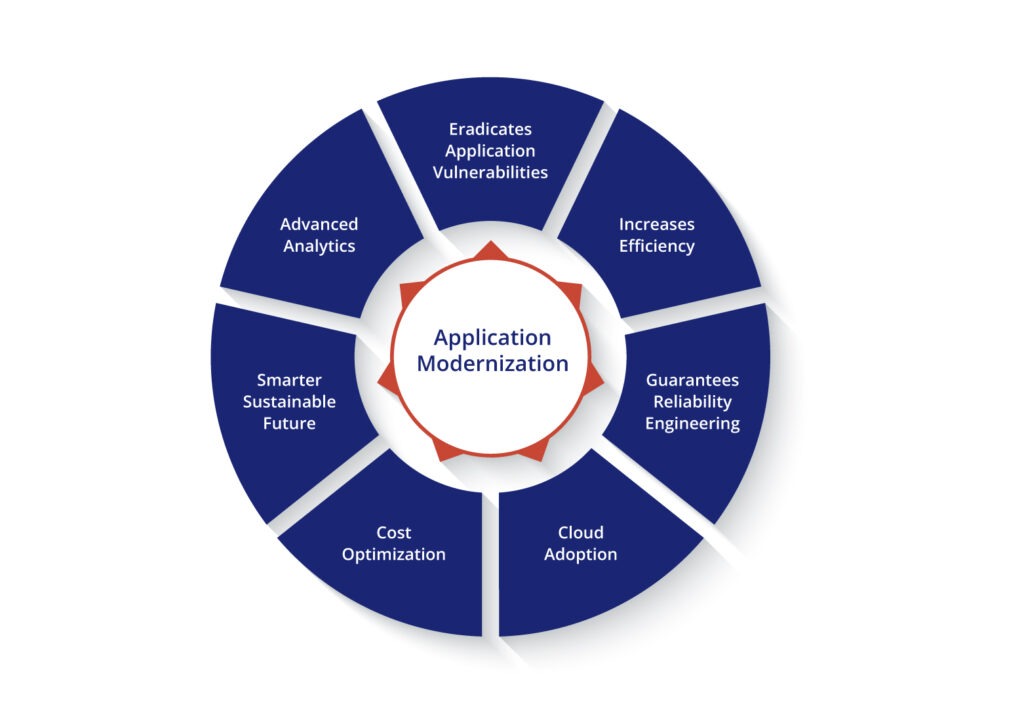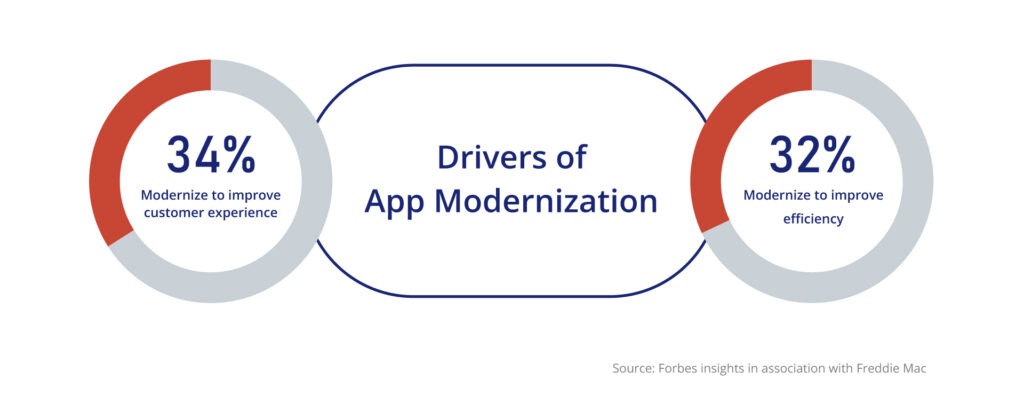Within the mortgage industry, companies are adopting new technologies to streamline and optimize operations, resulting in digital transformation(DX). A critical aspect of this transformation is application modernization.
So, what is application modernization? Application modernization, in short, refers to the process of updating obsolete legacy applications, which can become impediments to DX due to their monolithic structures and lack of agility and scalability, to take advantage of new technologies and industry standards.
This article discusses the challenges faced by mortgage companies relying on legacy applications, highlights the compelling reasons for application modernization, delves into the drivers of application modernization, and explores the most common pitfall of application modernization initiatives.
Legacy Application Challenges for Mortgage Enterprises
Some of the challenges faced by mortgage companies relying on legacy applications include:
1. Lack of quality engineering:
Over time, many mortgage businesses that rely on legacy applications often experience issues with bugs and errors. These problems can pose a risk to customers and employees, potentially leaving them vulnerable to cyber-attacks and other security threats.
2. Increased security risk:
In today’s technological landscape, it is vital to prioritize security. Older applications may be more vulnerable to cyber-attacks and malicious software or hardware. Additionally, some software may no longer receive security updates from the vendor, which can leave it non-compliant with current security standards and pose significant risks to cybersecurity.
According to the results of a recent survey, Gartner suggests that in 2023, there will be a 26.8% increase in cloud security spending. Failing to prioritize security may result in compromising customer data, costly fines, lawsuits, and damage to the reputation of mortgage businesses.
3. Lack of automated processes:
Legacy applications, which typically are not automated, tend to be slow and inefficient, resulting in manual errors that can cause endless delays in the mortgage process and, ultimately, decrease customer satisfaction.
4. Delayed customer support:
Meeting customer support expectations is crucial for mortgage businesses and outdated legacy applications complicate the process by making it difficult to identify and resolve issues, resulting in significant losses and reputational damage.
5. On-Premises Data Storage:
Older applications are stored on-premises, which means they are stored within the mortgage company’s data center rather than in the cloud, and this can create challenges in terms of accessibility, scalability, management, and maintenance and increases the risk of security breaches.
6. High Maintenance Systems and Infrastructure:
With time, managing antiquated legacy applications and the infrastructure that supports them can become complicated and, often, hinder a business’s ability to scale the applications as necessary and result in unnecessary expenses that could have been allocated toward other resources.
7. Unsatisfactory user experience:
Frequently, older software applications have outdated and challenging user interfaces that make it hard to use and navigate. These challenges can cause frustration for both customers and workers, which can hinder the effective use of the application and lead to lost business opportunities.
In the mortgage industry, several companies are losing customers to non-bank digital lenders such as Quicken Loans. These lenders have gained a substantial market share because of their user-friendly and easily accessible platform and convenient features.
Common Pitfall of App Modernization Initiatives
Many mortgage lenders are adopting digital technology to streamline their processes, such as using mobile apps for loan applications and customer experience platforms for digital campaigns. However, it is important to note that these advancements alone do not signify the completion of application modernization.
One of the main obstacles to completing the application modernization process is that many lenders have taken a piecemeal approach towards digitalizing their operations by implementing different technological tools and systems onto outdated legacy systems, which can’t fully cooperate with the new cloud-based applications.
As a result, this creates separate data silos and disconnected workflows that make it difficult to track the entire customer journey, thereby preventing mortgage lenders from leveraging insights to improve the customer experience (CX).
How Does Application Modernization Empower Mortgage Businesses?
Let’s explore how modern applications empowers various sectors within the mortgage industry.

Dev
1. Eradicates Application Vulnerabilities:
Mortgage companies using modern applications with cloud-native architecture to store sensitive customer information about borrowers have the latest security patches and updates, making them more robust and less likely to be vulnerable to security threats. Therefore, they are more difficult for cybercriminals to hack or exploit.
2. Increases Efficiency:
The latest applications in the market are more efficient than legacy applications because they are built with advanced technology, making them more scalable and reliable. Moreover, these systems can integrate with other systems easily, simplifying the consolidation of customer data for processing mortgage applications and streamlining procedures.
Upgrading the application leads to faster processing, greater customer satisfaction, reduced turnaround times, and improved ROI for the mortgage businesses.
Ops
1. Guarantees Reliability Engineering:
When mortgage businesses modernize their applications, reliability engineering becomes an important aspect. This helps mortgage businesses enhance the reliability of loan applications by performing tests, monitoring, and automation to minimize risks and prevent outages and failures. Ultimately, this leads to greater customer satisfaction and reduced costs.
Reliability engineering can assist mortgage businesses in enhancing the scalability of their mortgage application process, allowing them to adjust to shifting customer requirements and helping improve operational efficiency.
2. Incorporates Cloud Adoption:
Incorporating cloud adoption as part of application modernization provides a competitive advantage over legacy applications as it eliminates manual tasks and enhances efficiency. By automating the loan underwriting process, businesses can allocate staff resources to other critical tasks, ultimately improving overall productivity.
3. Optimizes Costs:
For mortgage businesses that are in the process of modernizing applications, adopting a microservices architecture can be an excellent way to optimize costs. By utilizing microservices, these businesses can scale individual components according to their needs leading to potential savings by only paying for essential resources.
4. Provides a smarter, sustainable future:
Modernizing apps is an effective way to enhance the sustainability of mortgage businesses. By minimizing dependence on non-renewable resources, eliminating waste, and leveraging the power of cloud computing providers, businesses can optimize their resource usage for a more sustainable future.
Revenue
1. Advances Analytics:
Modernized applications use cloud-based technologies that offer scalability and elasticity, making it easier for businesses to collect, store, manage, and analyze data. Advanced analytics tools and techniques help identify trends and insights to meet changing needs and improve decision-making.
Drivers of Application Modernization in Mortgage Industry

The stats from a survey by Forbes Insights in association with Freddie Mac above illustrate that with digital-native and hyper-personalized expectations on the rise, many mortgage institutions like Wells Fargo, Pulte Mortgage, Santander, and others, are modernizing their applications to meet the evolving needs and expectations of customers who value efficiency, accessibility, control over their mortgage experience, and seamless omnichannel journeys when selecting a mortgage lender.
Take away:
The mortgage industry is a significant financial services sector, and to remain competitive, mortgage lenders must update their operations. The first crucial step for achieving this is by modernizing their legacy systems and applications. By doing so, businesses can benefit from enhanced functionality, improved scalability, and increased agility.
If you’re looking to seamlessly transition your application systems, connect with our experts at AppsTek Corp to get started!
Modernize Mortgage Experiences NOW!




